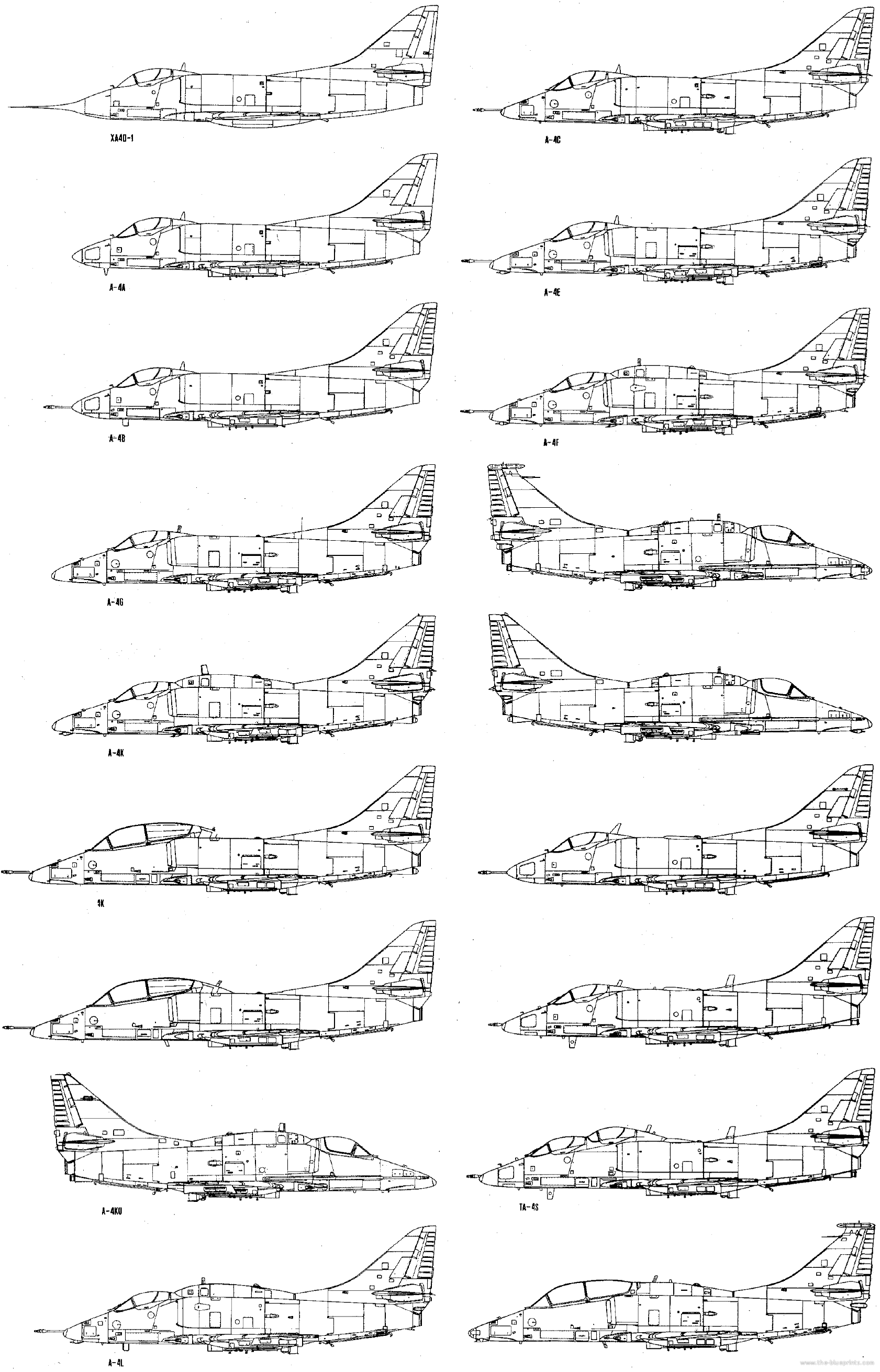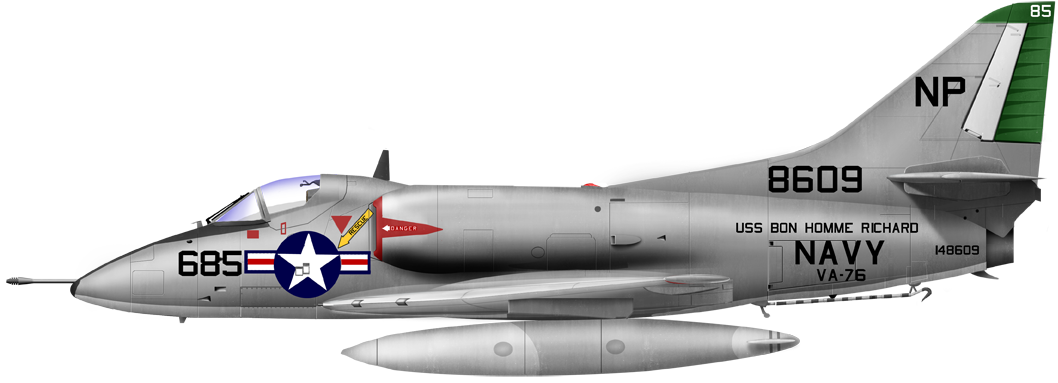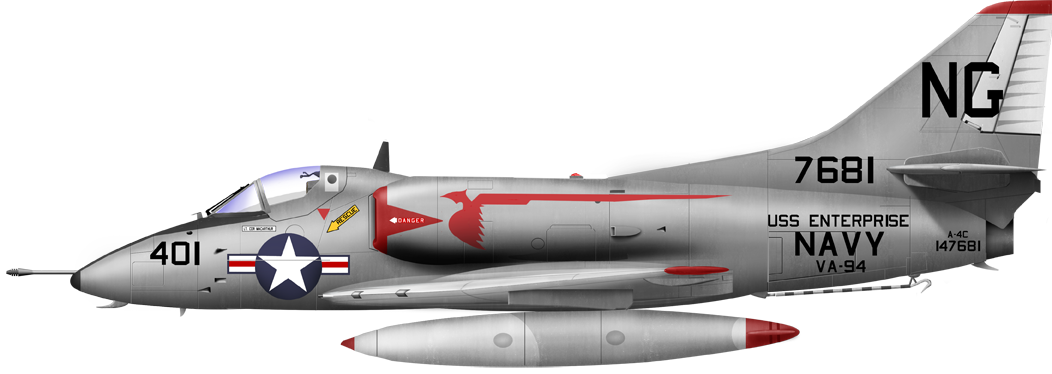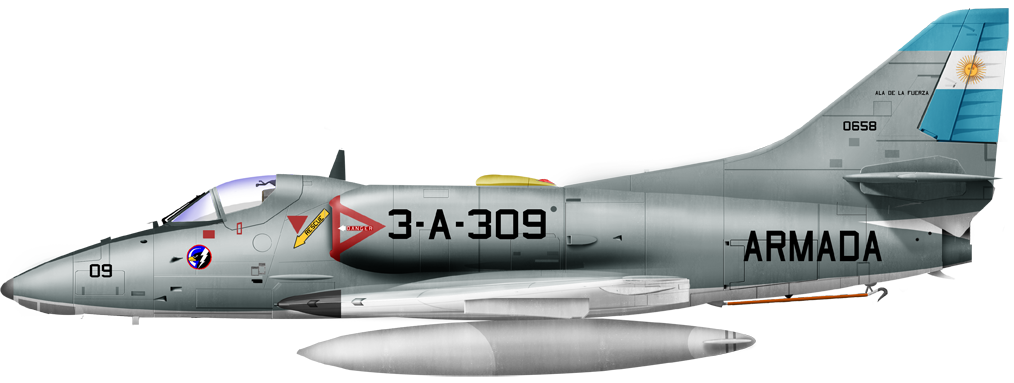The first Grumman Jet Fighter

The Douglas A-4 Skyhawk is a renowned carrier-capable light attack aircraft developed by Douglas Aircraft Company in the early 1950s. Design and Development: Designer: Ed Heinemann, a famed aircraft designer, led the development of the Skyhawk. First Flight: The prototype flew for the first time on June 22, 1954.
Design Features:
Delta Wing: The Skyhawk features a low-mounted delta wing without complex folding mechanisms, which simplified construction and maintenance. Compact Size: Known for its small size, the A-4 was dubbed "Heinemann's Hot Rod" for its sleek design and agility. Speed and Range: Powered by a single turbojet engine, it could achieve speeds of up to 670 mph (1,080 km/h) and had a range of over 2,000 miles (3,200 km) with drop tanks.
Armament: Equipped with two 20mm cannons and capable of carrying a variety of bombs, rockets, and missiles on its five hardpoints.
Operational History:
U.S. Navy and Marine Corps: The Skyhawk served prominently in the Vietnam War, performing ground-attack missions and playing a key role in the U.S. Navy's air operations.
Notable Users:
Blue Angels: The U.S. Navy's flight demonstration squadron flew the A-4 from 1974 to 1986. International Service: Besides the U.S., the Skyhawk was used by several other countries, including Argentina, Israel, Australia, and New Zealand. Combat Roles:
Ground Attack: Primarily designed for close air support and ground attack missions.
Nuclear Capable: It was one of the first aircraft designed to deliver nuclear weapons from aircraft carriers.
Versatility: The Skyhawk's adaptability allowed it to serve in various roles, including training, aerial refueling (with buddy stores), and even as an adversary aircraft for training purposes.
Variants

- A-4B: An improved version with a more powerful engine and better avionics.
- A-4C: Featured upgraded radar and bombing systems.
- A-4E/F: Included further avionics enhancements, more powerful engines, and additional hardpoints.
- A-4M: Developed specifically for the U.S. Marine Corps with advanced avionics and increased survivability features.
- TA-4: A two-seat trainer version used for training pilots.
Work in Progress, release planned 2025
Development
(To Come)Design
.jpg)
(To come)
⚙ Douglas A4 Skyhawk specifications | |
| Gross Weight | 9,853 lb (4,469 kg)/16,216 lb (7,355 kg) |
| Max Takeoff weight | 24,500 lb (11,113 kg) |
| Lenght | 40 ft 1.5 in (12.230 m) |
| Wingspan | 27 ft 6 in (8.38 m) |
| Height | 15 ft 2 in (4.62 m) |
| Wing Area | 260 sq ft (24 m2) |
| Engine | Pratt & Whitney J52-P-6A turbojet engine, 8,500 lbf (38 kN) thrust |
| Top Speed, sea level | |
| Cruise Speed | 585 kn (673 mph, 1,083 km/h) at sea level |
| Range | 1,008 nmi (1,160 mi, 1,867 km) |
| Climb Rate | 5,750 ft/min (29.2 m/s) |
| Ceiling | (to come) |
| Armament | 2× 20 mm (0.79 in) Colt Mk 12 cannon, 8,500 lb (3,900 kg) hardpoints. |
| Crew | 1 pilot |
Combat Records
Gallery:

A4C VA-76 USS Bonhomme Richard

A4C va94 CVAN-65 USS Enterprise

A4G Skyhawk VF805 HMAS Melbourne 1980

A4U Skyhawk from Brazil

A4Q Argentinian, Aircraft Carrier 21 De Mayo 1982








A4C VA-76 USS Bonhomme Richard

A4C va94 CVAN-65 USS Enterprise

A4G Skyhawk VF805 HMAS Melbourne 1980

A4U Skyhawk from Brazil

A4Q Argentinian, Aircraft Carrier 21 De Mayo 1982
Photos







Videos:
The Models Corner:
-To comeSources
- Lohner E (1913)
- Macchi M3 (1916)
- Macchi M5 (1918)
- Ansaldo ISVA (1918)
- Sopwith Baby (1916)
- Short 184 (1916)
- Fairey Campania (1917)
- Sopwith Cuckoo (1917)
- Felixstowe F.2 (1917)
- Friedrichshafen FF 33 (1916)
- Albatros W4 (1916)
- Albatros W8 (1918)
- Hanriot HD.2
- Grigorovitch M5
- IJN Farman MF.7
- IJN Yokosho Type Mo
- Yokosho Rogou Kougata (1917)
- Yokosuka Igo-Ko (1920)
- Curtiss N9 (1916)
- Aeromarine 39
- Vought VE-7
- Douglas DT (1921)
- Boeing FB.5 (1923)
- Boeing F4B (1928)
- Vought O2U/O3U Corsair (1928)
- Blackburn Blackburn (1922)
- Supermarine Seagull (1922)
- Blackburn Ripon (1926)
- Fairey IIIF (1927)
- Fairey Seal (1930)
- LGL-32 C.1 (1927)
- Caspar U1 (1921)
- Dornier Do J Wal (1922)
- Rohrbach R-III (1924)
- Mitsubishi 1MF (1923)
- Mitsubishi B1M (1923)
- Yokosuka E1Y (1923)
- Nakajima A1N (1927)
- Nakajima E2N (1927)
- Mitsubishi B2M (1927)
- Nakajima A4N (1929)
- CANT 18
WW1
✠ K.u.K. Seefliegerkorps:
 Italian Naval Aviation
Italian Naval Aviation
 RNAS
RNAS
 Marineflieger
Marineflieger
 French Naval Aviation
French Naval Aviation
 Russian Naval Aviation
Russian Naval Aviation
 IJN Air Service
IJN Air Service
 USA
USA
Interwar
 Interwar US
Interwar US
 Interwar Britain
Interwar Britain
 Interwar France
Interwar France
 Interwar Germany
Interwar Germany
 Interwar Japan
Interwar Japan
 Interwar Italy
Interwar Italy
- Curtiss SOC seagull (1934)
- Grumman FF (1931)
- Curtiss F11C Goshawk (1932)
- Grumman F2F (1933)
- Grumman F3F (1935)
- Northrop BT-1 (1935)
- Grumman J2F Duck (1936)
- Consolidated PBY Catalina (1935)
- Brewster/NAF SBN-1 (1936)
- Curtiss SBC Helldiver (1936)
- Vought SB2U Vindicator (1936)
- Brewster F2A Buffalo (1937)
- Douglas TBD Devastator (1937)
- Vought Kingfisher (1938)
- Curtiss SO3C Seamew (1939)
- Douglas SBD Dauntless (1939)
- Grumman F4F Wildcat (1940)
- F4U Corsair (NE) (1940)
- Brewster SB2A Buccaneer (1941)
- Grumman TBF/TBM Avenger (1941)
- Consolidated TBY Sea Wolf (1941)
- Grumman F6F Hellcat (1942)
- Curtiss SB2C Helldiver (1942)
- Curtiss SC Seahawk (1944)
- Grumman F8F Bearcat (1944)
- Ryan FR-1 Fireball (1944)
- Douglas AD-1 Skyraider (1945)
Fleet Air Arm
- Fairey Swordfish (1934)
- Blackburn Shark (1934)
- Supermarine Walrus (1936)
- Fairey Seafox (1936)
- Blackburn Skua (1937)
- Short Sunderland (1937)
- Blackburn Roc (1938)
- Fairey Albacore (1940)
- Fairey Fulmar (1940)
- Grumman Martlet (1941)
- Hawker sea Hurricane (1941)
- Brewster Bermuda (1942)
- Fairey Barracuda (1943)
- Fairey Firefly (1943)
- Grumman Tarpon (1943)
- Grumman Gannet (1943)
- Supermarine seafire (1943)
- Blackburn Firebrand (1944)
- Hawker Sea Fury (1944)
IJN aviation
- Aichi D1A "Susie" (1934)
- Mitsubishi A5M "Claude" (1935)
- Nakajima A4N (1935)
- Yokosuka B4Y "Jean" (1935)
- Mitsubishi G3M "Nell" (1935)
- Nakajima E8N "Dave" (1935)
- Kawanishi E7K "Alf" (1935)
- Nakajima B5N "Kate" (1937)
- Kawanishi H6K "Mavis" (1938)
- Aichi D3A "Val" (1940)
- Mitsubishi A6M "zeke" (1940)
- Nakajima E14Y "Glen" (1941)
- Nakajima B6N "Jill" (1941)
- Mitsubishi F1M "pete" (1941)
- Aichi E13A Reisu "Jake" (1941)
- Kawanishi E15K Shiun "Norm" (1941)
- Nakajima C6N Saiun "Myrt" (1942)
- Yokosuka D4Y "Judy" (1942)
- Kyushu Q1W Tokai "Lorna" (1944)
Luftwaffe
- Arado 196 (1937)
- Me109 T (1938)
- Blohm & Voss 138 Seedrache (1940)
Italian Aviation
- Savoia-Marchetti S.55
- IMAM Ro.43/44
- CANT Z.501 Gabbiano
- CANT Z.506 Airone
- CANT Z.508
- CANT Z.511
French Aeronavale
- GL.300 (1926-39)
- Levasseur PL.5 (1927)
- Potez 452 (1935)
- Loire 210 (1936)
- Loire 130 (1937)
- LN 401 (1938)
Soviet Naval Aviation
- Shavrov SH-2 (1928)
- Tupolev TB-1P (1931)
- Beriev MBR-2 (1930)
- Tupolev MR-6 (1933)
- Tupolev MTB-1 (1934)
- Beriev Be-2 (1936)
- Polikarpov I16 naval (1936)
- Tupolev MTB-2 (1937)
- Ilyushine DB-3T/TP (1937)
- Beriev Be-4 (1940)
-
Skoda Š-328V
R-XIII Idro
Fokker C.XI W (1934)
WW2
- De Havilland Sea Vixen
- Hawker Sea Hawk
- Supermarine Scimitar
- Blackburn Buccaneer
- Hawker Sea Harrier
- Douglas A4 Skyhawk
- Grumman F9F Panther
- Vought F8 Crusader
- McDonnell-Douglas F-4 Phantom-II
- North Am. A5 Vigilante
- TU-142
- Yak 38 forger
☢ Cold War
✧ NATO
 Fleet Air Arm
Fleet Air Arm
 US Navy
US Navy
☭ Warsaw Pact
Merch

Seafire Mark 45; HMS Pretoria Castle

Zeros vs its aversaries

Aichi D3A “Val” Junyo

Mitsubishi A5M poster

F4F wildcat

Macchi M5

SBD Dauntless Coral Sea

SBD Dauntless USS Enterprise

SBD-4 CV22
